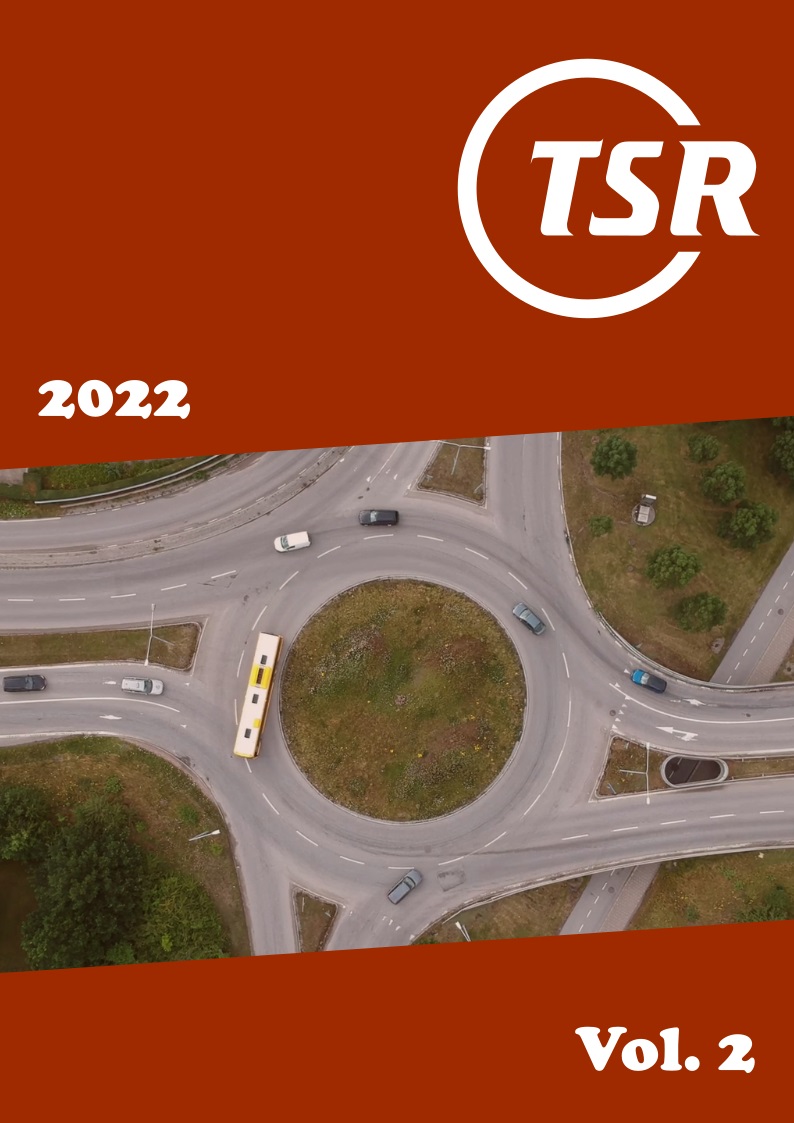Distracting or informative? Examining signage for cyclists using eye-tracking
DOI:
https://doi.org/10.55329/wxcy5694Keywords:
cyclist, eye-tracking, machine learning, signsAbstract
There is great political motivation to improve conditions for cyclists to help solving the transport needs of the future. We used eye-tracking to collect data and analysed it using a novel machine learning approach. 40 cyclists in total were tasked with navigating a set route through the Oslo city centre. One group before the new infrastructure was in place and one group after. The analysis focused on developing a method that could be used to investigate how a new signage strategy impacted cyclists in Oslo. Improving signage could create safer traffic conditions for cyclists, while avoiding adding distracting elements. The algorithms developed were able to detect and categorize a variety of important objects. The signage system itself seemed to result in some route change among cyclists, but not all followed the suggested route. Qualitative analyses suggests that those who deviated cycled faster and looked less at signs, than those who chose the suggested route. The paper discusses strengths and weaknesses involved in this approach. While useful, one should be careful to conclude that gaze behaviour reflects the true inner consciousness of cyclists.
Downloads
References
Aasvik, O., T. Bjørnskau (2021), ‘Cyclists' Perception of Maintenance and Operation of Cycling Infrastruc-ture—Results From a Norwegian Survey’, Frontiers in Psychology, 12, 696317, https://doi.org/10.3389/fpsyg.2021.696317.
Bjørnskau, T. (2020), ‘Risiko i veitrafikken 2017/18’ [Road traffic risk in Norway 2017/18] (Oslo, Norway: Institute of Transport Economics), TØI rapport 1782/2020, https://www.toi.no/getfile.php?mmfileid=54458, accessed 4 September 2022.
Brazil, W., A. O'Dowd, B. Caulfield (2017), ‘Using eye-tracking technology and Google street view to understand cyclists' perceptions’, presented at IEEE 20th International Conference on Intelligent Transportation Sys-tems (Yokohama, Japan: 16–19 October 2017), https://doi.org/10.1109/ITSC.2017.8317619.
Brown, H., C. Sun, Z. Qing (2017), ‘Investigation of Alternative Bicycle Pavement Markings with the Use of a Bicycle Simulator’, Transportation Research Record: Journal of the Transportation Research Board, 2662, 143–151, https://doi.org/10.3141/2662-16.
Cai, L., R. Yang, Z. Tao (2018), ‘A new method of evaluating signage system using mixed reality and eye track-ing’, presented at 4th ACM SIGSPATIAL International Workshop on Safety and Resilience (Seattle WA, USA: 6 November 2018), https://doi.org/10.1145/3284103.3284105.
Connor, C. E., H. E. Egeth, S. Yantis (2004), ‘Visual attention: bottom-up versus top-down’, Current Biology, 14 (19), R850–R852, https://doi.org/10.1016/j.cub.2004.09.041.
Cowey, A. (2010), ‘The blindsight saga’, Experimental Brain Research, 200, 3–24, https://doi.org/10.1007/s00221-009-1914-2.
Espeland, M., K. S. Amundsen (2012), ‘Nasjonal sykkelstrategi 2014-2023’ [National cycling strategy 2014-2032] (Oslo: Vegdirektoratet), No. 7, https://www.vegvesen.no/globalassets/fag/fokusomrader/miljovennlig-transport/sykkeltrafikk/sykkelstrategi.pdf, accessed 24 September 2022.
Fyhri, A., O. Johansson, I. S. Hesjevoll (2021a), ‘Ny sykkelveivisning i Oslo: Før- og etterundersøkelse av for-søksstrekningen "Rute 2"’ [A new approach to route guidance for cyclists - a field study with eye trackers and GPS tracking] (Oslo, Norway: Institute of Transport Economics), https://www.toi.no/getfile.php?mmfileid=55299, accessed 24 September 2022.
Fyhri, A., K. Karlsen, H. B. Sundfør (2021b), ‘Paint it red-a multimethod study of the nudging effect of coloured cycle lanes’, Frontiers in Psychology, 12, 662679, https://doi.org/10.3389/fpsyg.2021.662679.
Grahn, H., T. Taipalus (2021), ‘Refining distraction potential testing guidelines by considering differences in glancing behavior’, Transportation Research Part F: Traffic Psychology and Behaviour, 79, 23–34, https://doi.org/10.1016/j.trf.2021.03.009.
Hoeke, L., J. de Kruijf, J. Soemers (2019), ‘Wayfinding op snelfietsroutes’ [Wayfinding on fast bicycle routes] (Breda, the Netherlands: Breda University of Applied Sciences), https://pure.buas.nl/ws/portalfiles/portal/1000608/Hoeke_Kruijf_Soemers_Rapportage_onderzoek_wayfinding_snelfietsroutes.pdf, accessed 24 September 2022.
Jennings, K., H. Milton, A. Munyama (2016), ‘Quietways Wayfinding User Testing: Debrief to London Grid Board’ (London, UK: 2CV & Transport of London), https://content.tfl.gov.uk/quietways-research.pdf, ac-cessed 24 September 2022.
Kovacsova, N., C. Cabrall, S. Antonisse, et al. (2018), ‘Cyclists’ eye movements and crossing judgments at un-controlled intersections: An eye-tracking study using animated video clips’, Accident Analysis & Prevention, 120, 270–280, https://doi.org/10.1016/j.aap.2018.08.024.
Kristjánsson, Á., G. Campana (2010), ‘Where perception meets memory: A review of repetition priming in visual search tasks’, Attention, Perception, & Psychophysics, 72 (1), 5–18, https://doi.org/10.3758/APP.72.1.5.
Københavns kommune (2015), ‘Evaluering af Albertslundruten under projekt ”Afmærkning og identitet på Supercykelstierne”’ [Evaluation of the Albertslund route under the project "Marking and identity on the Su-percycle trails"] (Copenhagen, Denmark: Teknik- og Miljøforvaltningen).
Lin, T.-Y., M. Maire, S. Belongie, et al. (2014), ‘Microsoft COCO: Common Objects in Context’, presented at European Conference on Computer Vision (Zurich, Switzerland: 5–12 September 2014), https://doi.org/10.1007/978-3-319-10602-1_48.
Lunke, E. B., B. Grue (2018), ‘Sykling og sykkelmål’ [Cycling and cycling goals] (Oslo, Norway: Institute of Transport Economics), TØI-rapport 1676/2018, https://www.toi.no/getfile.php/1349561-1547206572, ac-cessed 24 September 2022.
Mantuano, A., S. Bernardi, F. Rupi (2017), ‘Cyclist gaze behavior in urban space: An eye-tracking experiment on the bicycle network of Bologna’, Case Studies on Transport Policy, 5 (2), 408–416, https://doi.org/10.1016/j.cstp.2016.06.001.
Milch, V., A. Fyhri, T. de Jong, F. Sagberg (2019), ‘Hvordan vise veien? Grunnlag for nytt veivisningskonsept for syklende i Oslo og Akershus’ [Showing the way: Baseline report for a new bicycle wayfinding concept in Oslo and Viken] (Oslo, Norway: Institute of Transport Economics), TØI rapport 1726/2019, https://www.toi.no/getfile.php?mmfileid=52352, accessed 24 September 2022.
Regan, M. A., D. L. Strayer (2014), ‘Towards an Understanding of Driver Inattention: Taxonomy and Theory’, Annals of Advances in Automotive Medicine, 58, 5–13, https://pubmed.ncbi.nlm.nih.gov/24776222/.
Reisberg, D. (2013), Cognition: Exploring the Science of the Mind (New York, USA: W. W. Norton & Compa-ny) 5th International Student Edition.
Robbins, C. J., H. A. Allen, K. A. Miller, P. Chapman (2019), ‘The "Saw but Forgot" error: A role for short-term memory failures in understanding junction crashes?’, PloS One, 14 (9), e0222905, https://doi.org/10.1371/journal.pone.0222905.
Rupi, F., K. J. Krizek (2019), ‘Visual Eye Gaze While Cycling: Analyzing Eye Tracking at Signalized Intersec-tions in Urban Conditions’, Sustainability, 11 (21), 6089, https://doi.org/10.3390/su11216089.
Sagberg, F., A. Høye, H. B. Sundfør (2016), ‘"Jeg så ham ikke": Temaanalyse av uoppmerksomhet ved død-sulykker i trafikken’ ["I didn’t see him": Inattention as a factor in fatal road crashe] (Oslo, Norway: Institute of Transport Economics), TØI rapport 1535/2016, https://www.toi.no/getfile.php/1344924-1494240499.
Tang, M. (2020), ‘Analysis of signage using eye-tracking technology’, Interdisciplinary Journal of Signage and Wayfinding, 4 (1), 61–72, https://doi.org/10.15763/issn.2470-9670.2020.v4.i1.a56.
Timofte, R., K. Zimmermann, L. Van Gool (2014), ‘Multi-view traffic sign detection, recognition, and 3D locali-sation’, Machine vision and applications, 25 (3), 633–647, https://doi.org/10.1007/s00138-011-0391-3.
Zhang, Y., C. Fu, S. Cheng (2015), ‘Exploring Driver Injury Severity at Intersection: An Ordered Probit Analysis’, Advances in Mechanical Engineering, 7 (2), 567124, https://doi.org/10.1155/2014/567124.
Zoph, B., V. Vasudevan, J. Shlens, Q. V. Le (2018), ‘Learning Transferable Architectures for Scalable Image Recognition’, presented at IEEE/CVF Conference on Computer Vision and Pattern Recognition (Salt Lake City, UT, USA: 18–23 June 2018), https://doi.org/10.1109/CVPR.2018.00907.
Downloads
Published
How to Cite
Issue
Section
License
Copyright (c) 2022 Ole Aasvik, Aslak Fyhri

This work is licensed under a Creative Commons Attribution 4.0 International License.









